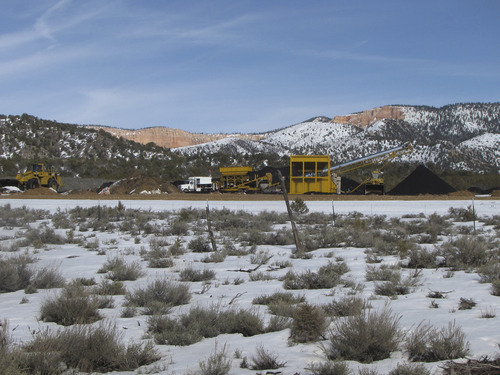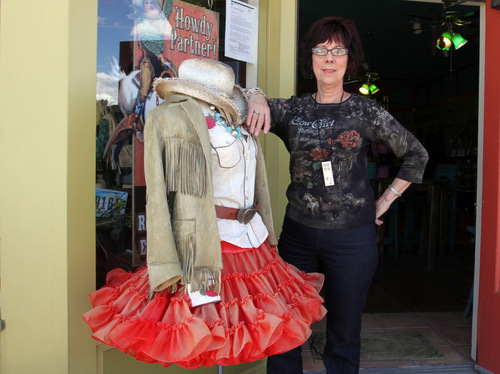This is an archived article that was published on sltrib.com in 2011, and information in the article may be outdated. It is provided only for personal research purposes and may not be reprinted.
Alton • Just south of this sleepy southern Utah town, a black mountain of coal is growing that will soon see a regular fleet of tractor-trailers hauling the fuel through Panguitch to Delta, where it will be burned to generate electricity.
The Coal Hollow Mine, where machinery will strip away the top layers of ground to extract up to 2 million tons of coal a year for three years, has been in the works for several years.
After receiving a permit from the state more than a year ago, Alton Coal Development LLC began the mining on 635 acres of private land. The Cedar City-based company hopes to mine an even larger section — about 3,500 acres — on adjoining Bureau of Land Management property. That plan is still in the permitting process.
The mine, about 10 miles from Bryce Canyon National Park in Kane County, is the only one in Utah removing coal from the surface in a process known as strip mining.
Last week the coal operation received two notices of violation from inspectors with the Utah Coal Regulatory Program.
One of the notices issued Thursday requires the company to remove snow and sediment along the southeast portion of Robinson Creek. It is also calling for the company to cease dumping untreated runoff into the natural channel of the creek and to provide adequate temporary sediment control.
The second notice, also issued Thursday, requires the company to remove topsoil temporarily stockpiled between the creek and a diversion of the creek, and to build adequate protection measures like a berm, straw bales or silt fence at the base of each stockpile that should also be seeded.
Neither notice calls for mining operations to cease.
Jim Springer, a spokesman for the Utah Division of Oil, Gas and Mining, said the division's regulatory program conducts monthly inspections of mines to ensure compliance with state rules.
He said that new start-up mines like Coal Hollow are inspected up to three times a month.
"Division inspectors will ensure corrective actions are taken by the dates on the [notices]," Springer said. "There will in all probability be some fines involved but those have not been set. In the overall scheme of mine operations, both [notices] are considered minor and easily corrected."
Officials with Alton Coal Development did not respond to requests from The Salt Lake Tribune for comment.
Since being proposed in 2004, the mine has faced opposition from environmental groups and residents in the nearby towns of Hatch and Panguitch in Garfield County.
In March 2010, the Southern Utah Wilderness Alliance and some other environmental groups filed a complaint stating the Division of Oil, Gas and Mining Board had some members who should recuse themselves from the permit process because they have a financial interest in the mine-reclamation plan.
Steve Bloch, an attorney and the conservation director for SUWA, said the complaint is scheduled to be heard by the Utah Supreme Court.
Mine critic Bobbi Bryant, who runs a store in Panguitch, said last week that since mid-February, trucks have intermittently been hauling their loads past her store on Highway 89 on their way to the coal-fired power plant operated by Intermountain Power Service Corp. just outside Delta, nearly 200 miles away in Millard County.
In response to an e-mail inquiry from The Tribune, Jon Finlinson, president of Intermountain Power Service Corporation, confirmed the company has a contract to receive coal by truck from Coal Hollow Mine.
To get to Delta, the trucks pass through Panguitch, which frustrates Bryant.
She said the trucks are supposed to be closed to reduce the spread of coal dust, but are not, and that the company has hired only three residents, though saying it planned to hire more.
She said the trucks also increase vibrations that are contributing to crumbling of the brick facade of her store, which is housed in an old building. "I go out to sweep my sidewalk and find little pieces of brick from the front wall," Bryant said.
She also complained that during the permitting process for the mine, the public's concerns were ignored.
"Our complaints fell on deaf ears," she said.
She hopes their concerns are taken more seriously by the Bureau of Land Management, which is doing an environmental impact statement on Alton Coal's application to mine adjoining land.
Keith Rigtrup, the BLM's environmental impact statement project manager, said he could not comment on the specifics of the document that is still being reviewed before it's released to the public in three or four months.
Once the EIS is released, the public will have a chance to comment on the document, which will have alternatives ranging from not issuing the lease to different production and mitigation rules, he said.
If the lease is approved, it will go to public auction and will be awarded to the highest bidder, which means a company other than Alton Coal could be awarded the lease.
Rigtrup said that if the lease is approved, whoever gets it has 10 years to start mining or the lease is withdrawn.
That is what happened when a previous lease for the property was approved in the 1980s, but the company never developed the land, so the lease was canceled in the 1990s.





